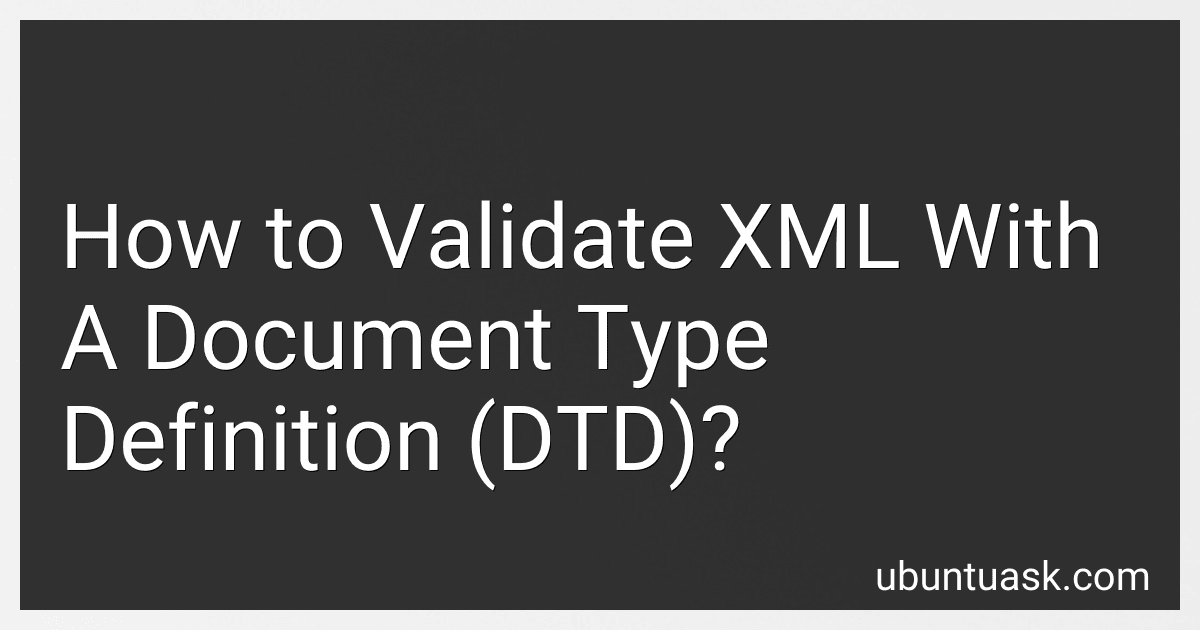Best DTD Validation Tools to Buy in December 2025
Sure! Validating an XML document with a Document Type Definition (DTD) involves the following steps:
- Create a DTD: Create a DTD file that defines the structure and content rules for the XML document. The DTD specifies the elements, attributes, and their allowed content.
- Link the DTD to the XML document: In the XML document, include a reference to the DTD file using the declaration. The declaration should specify the location of the DTD file.
- Enable validation: Enable the validation process in your programming language or XML editor. For example, in Java, you can use the DocumentBuilderFactory class to set validation on.
- Parse the XML document: Use a parser to load and parse the XML document against the DTD. The parser will validate the XML against the defined rules in the DTD.
- Handle validation errors: If there are any validation errors, the parser will raise exceptions or errors indicating the issues found. You should handle and address these errors appropriately.
- Review validation results: Once the validation process is complete, review the results to ensure the XML document adheres to the rules defined in the DTD. This ensures the document is valid and correctly structured.
By validating XML with a DTD, you can ensure that the document conforms to the specified structure and adhere to the rules defined in the DTD. This helps in maintaining data integrity, interoperability, and consistency across different XML documents.
How to specify REQUIRED and IMPLIED attributes in DTD?
To specify REQUIRED and IMPLIED attributes in a DTD (Document Type Definition), you can use the following notations:
- REQUIRED Attribute: To specify that an attribute is required, you can add the #REQUIRED keyword after the attribute name within the element declaration. Here is an example: In the above example, the element "element_name" must have an attribute called "attribute_name", and it is required.
- IMPLIED Attribute: To specify that an attribute is optional or implied, you can use the #IMPLIED keyword after the attribute name within the element declaration. Here is an example: In the above example, the element "element_name" may have an attribute called "attribute_name", but it is optional.
Note: The DTD defines the structure and validity of an XML document through element and attribute declarations. The above examples assume that the element's content model is specified appropriately as per your requirements.
What is the role of DTD in XML validation?
The Document Type Definition (DTD) plays a crucial role in XML validation. It is used to define the structure, data types, and properties of the elements and attributes in an XML document.
The main purpose of a DTD is to provide a set of rules or specifications to ensure that an XML document adheres to a predefined structure. It defines the valid elements and attributes that can be used in the document, and their hierarchical relationships. The DTD also specifies the data types, default values, and constraints for the elements and attributes.
During the validation process, the XML parser compares the structure and content of the XML document against the rules defined in the DTD. If any inconsistencies or violations are found, such as missing elements or incorrect data types, the XML document is considered invalid.
In summary, the role of DTD in XML validation is to define a schema that determines the allowed structure and content of an XML document, ensuring its conformance to a specific set of rules and requirements.
What is an element declaration in DTD?
In Document Type Definition (DTD), an element declaration defines the structure and characteristics of an XML element. It defines the name of the element, the content model, and other attributes associated with the element.
An element declaration consists of the following components:
- Name: It specifies the name of the element.
- Content Model: It defines the allowed content and structure of the element. It can be defined using various operators like element names, mixtures, sequences, choices, etc.
- Attributes: It specifies the attributes associated with the element, including their names, types, and default values.
- Empty Element Markup: It defines whether the element can be empty or must have content.
- Declaration Type: It determines the type of the element declaration, which can be either DTD internal or external.
By defining element declarations in DTD, you can ensure that XML documents adhere to a specific structure, making it easier to validate and process the data contained within them.
